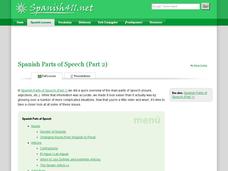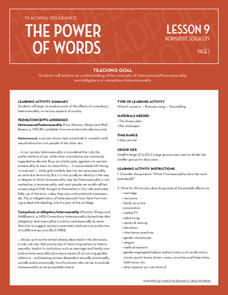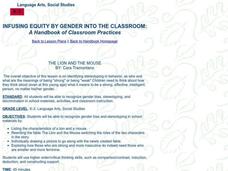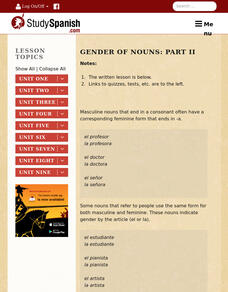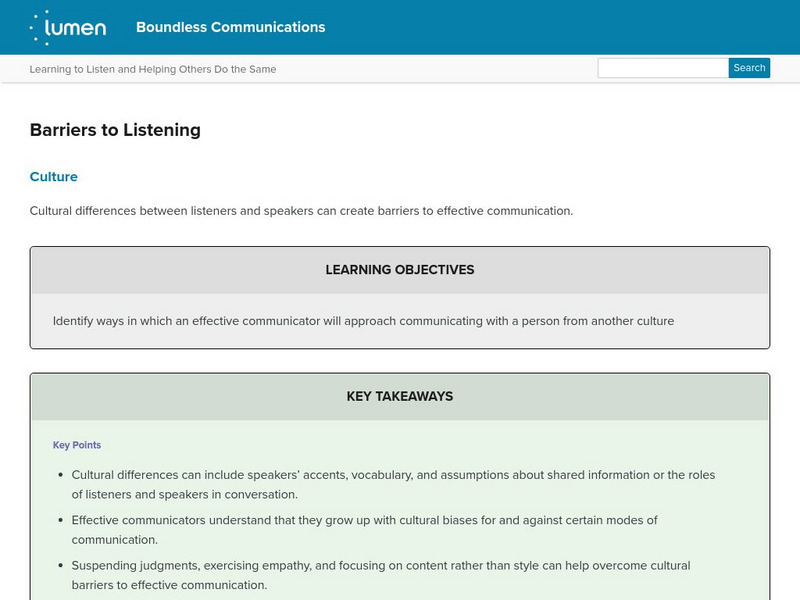Curated OER
Spanish Parts of Speech (Part 2)
Zoom in on a few parts of speech to strengthen and deepen understanding. Pupils examine nouns, articles, adjectives, and conjunctions in closer detail, looking at more complex grammatical situations. In addition to the informational page...
Curated OER
Describing Family - Lesson Plan
Students describe their family in their new language French. They use adjectives, and proper gender. Then they describe how the family is alike and different.
Curated OER
Spanish Grammar
There are four ways to say "the" in Spanish: el, la, los, and las. This PowerPoint explains when it is appropriate to use either word, lists examples, as well as asks over thirty practice questions. Furthermore, this...
National Council for Curriculum and Assessment
Junior Certificate Latin: Defined Vocabulary List
Support your Latin language learners with a collection of vocabulary words paired with definitions. Kind of like a small dictionary, this reference material contains about 600 Latin words with English definitions.
Curated OER
Adjectives
After your Spanish scholars have mastered basic adjectives and are more familiar with the Spanish sentence structure, they'll be ready to learn descriptive adjectives. This resource sheet provides definitions, explanations, and examples...
Curated OER
Spanish Articles: Definite and Indefinite
This reference guide provides the basic information for definite and indefinite articles in Spanish. First, a brief introduction to definite and indefinite articles in English helps set the stage for the Spanish versions. Pair this with...
Curated OER
Lesson: Elizabeth Peyton: Artist's Community: The Real
What is real or imagined? The lines of beauty reality, and imagination are blurred in Elizabeth Peyton's portraits of her community. Learners analyze her use of artistic technique in conveying real and imagined communities. They then use...
Curated OER
English Vocabulary Skills: AWL Sublist 6 - Exercise 3b
In this online interactive English vocabulary skills instructional activity, students answer 10 matching questions which require them to fill in the blanks in 10 sentences. Students may submit their answers to be scored.
Curated OER
Pronouns
Subject, object personal. Possessive, reflexive, indefinite. Everything you want to know about pronouns and their antecedents is contained in a colorful 32-slide presentation.
Teaching Tolerance
The Power of Words: Normative Sexuality
High schoolers collect newspaper articles which discuss societies who enforce heterosexuality. They brainstorm how heterosexuality is enforced in their community. They answer questions to end the instructional activity.
Curated OER
The Lion and the Mouse
Students write a story. In this critical thinking and writing lesson, students read a fable, answer the provided thinking skills questions, and write their own fable.
Curated OER
Grammatical Person: 1st, 2nd, and 3rd Person
In this grammatical person: first, second, and third person worksheet, learners determine the speaker/participants relationship. Students use a chart to identify grammatical person in seventeen sentences.
Curated OER
THE LION AND THE MOUSE
Pupils listen to a story about different types of animals and explore how they all need each other, just like people do.
Curated OER
Falling Leaves: The True Story of an Unwanted Chinese Daughter
Students read the novel Falling Leaves. They evaluate the repeated story lines which compose the history of narration. They analyze and defend reasons why self-esteem affects the success or failure of characters.
Curated OER
Adjectives: Forms And Usage
In this adjective forms and usage instructional activity, 7th graders review and discuss all the different types of adjective forms and usage and complete one sentences with an article, a noun and an adjective.
Curated OER
The Power of Words
Students research the power of words and the necessary teaching of tolerance. In groups, they research a particular word given to them about a group in society. They trace the origin of the word and form a stance on how they view the...
Curated OER
Development
In this psychology learning exercise, students complete 5 short answer questions on human's developmental stages and Kohlberg's theory.
Study Languages
Study Spanish: Gender of Nouns Part Ii
Outstanding lesson that presents most of the word endings that determine gender. It also considers common exceptions to the rule. Without a doubt, this lesson shines above all others in teaching students how to determine the gender of a...
University of Texas at Austin
Tex's French Grammar: Gender
This French language resource has written and audio examples as well as listening comprehension and interactive written exercises. Lists the endings associated with masculine or feminine nouns.
Sophia Learning
Sophia: Masculine & Feminine Traits: Lesson 2
At the end of this tutorial, the learner will understand that various cultures identify certain behavioral traits as masculine or feminine. It is 2 of 3 in the series titled "Masculine & Feminine Traits."
Lumen Learning
Lumen: Boundless Communications: Barriers to Listening
This lesson plan focuses on barriers to listening including cultural differences, gender, and technological distractions.
University of Texas at Austin
Intoduction to French Nouns
This concise overview of French nouns inncludes a general definition, examples of gender and number, count vs. mass and common vs. proper.
University of Texas at Austin
Tex's French Grammar: Irregular Adjectives
This site, from Tex's French Grammar, is an excellent site which has a clear, concise explanation of adjectives that are irregular for gender or in forming plurals (doux/douce, faux.fausse, etc.). It provides examples and interactive...
University of Texas at Austin
University of Texas: Francais Interactif
This full-featured interactive textbook encounter utilizes French speakers in real life scenarios. Well structured for work on grammatical concepts (links to Tex's French Grammar), vocabulary, listening comprehension and exposure to...


